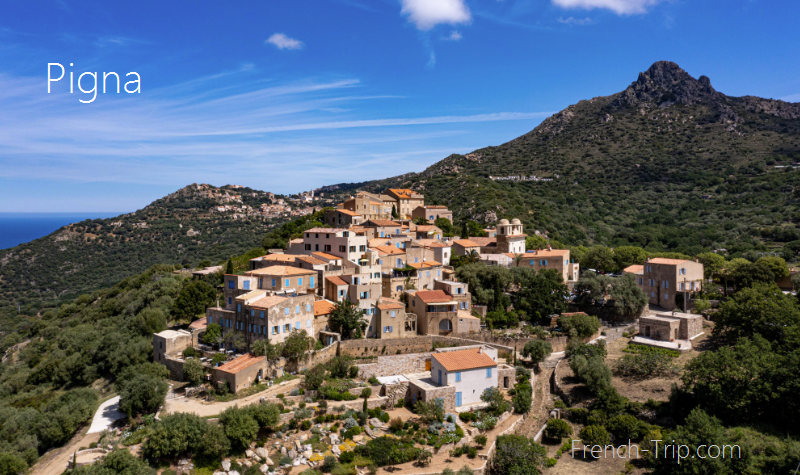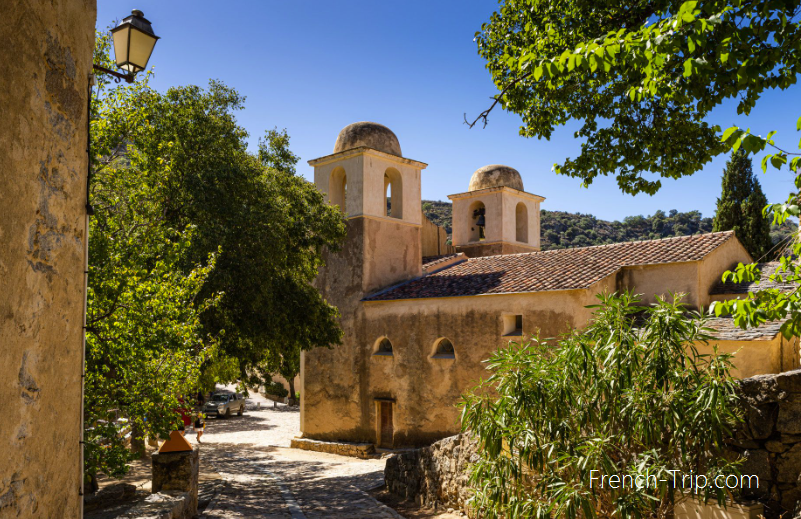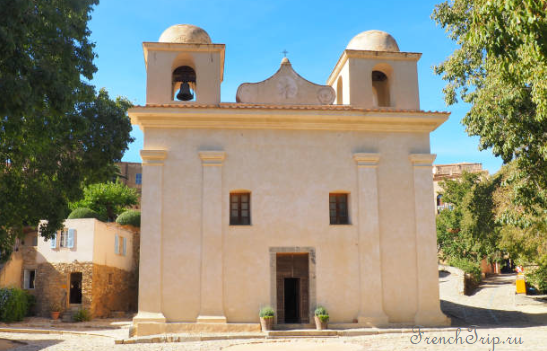Pigna

Discover one of the most visited places in the Balagne region of Corsica, the village of Pigna with its orange roofs, blue shutters and workshops of artisans and artists. Situated on a rocky spur, not far from L’Île-Rousse, it offers stunning panoramic views of the Mediterranean coast and can be a great option to diversify your beach holiday. Its narrow streets filled with flowers and a beautiful square will charm you. In addition, crafts and music are very much revered here: the Festivoce festival in July is dedicated to polyphony (traditional Corsican vocal music), dance and theatre.
It is also a great base for exploring other gems of Balagne, such as Sant’Antonio, one of the most beautiful villages in France, or Aregno and Algajola.
Pigna Travel Guide
Pigna is a very pretty village, beautifully restored. It is entirely pedestrian, with parking on the outskirts of the village. Stroll around the village, enjoying its beautiful architecture, and take a look inside the church with a modern fresco and a small marble statue of the Virgin. Have lunch in one of the local restaurants, sitting on the terrace with panoramic views of the coast and the neighboring village of Corbara.
Weather in Pigna:
Getting to Pigna
Transportation in Corsica is not very good, so the only way to get to these small villages is by car. You can leave your car in the large parking lot located at the entrance to the old town.
- Travel time from Ile Rousse = 15 minutes.
- Travel time from Calvi = 30 minutes.
You can also walk between the different villages, especially between Sant’Antonio and Pigna: it’s about a 45-minute walk.
In high season there may not be enough parking, so it’s better to arrive either early or late.
There are also a few spots along the main road, but check the signs, some spots are private. And don’t park on the road!
By bus:
There is one bus to Pigna: Route №4 : L’Île-Rousse — Corbara —PIGNA —L’Île-Rousse
- 6 buses per day
- Fares: temporally free as an experiment of Balagne transport system
- Timetable (Monday – Friday)
- Timetable Saturday
- No buses during Sundays and Public holidays
- website
Useful tips
- Take an hour to explore the village, enjoy the views and visit the artisan shops.
- Wear comfortable walking shoes as the ground is rocky and very uneven.
- The village is set on fairly steep slopes.
- It is a great option for lunch, with several restaurants with panoramic terraces and views of the coast.
- The interior of the village is entirely pedestrianised.
Pigna History
In 862, Consalvo, one of Count Guido Savelli’s lieutenants sent by the Pope to liberate Corsica from the Saracens, built a tower called Pigna in memory of his native Roman county.
Music is at the heart of life in Pigna. The village lay abandoned for much of the mid-20th century before an association was formed in the 1960s to renovate the houses and form a community of musicians and artists. This was a great success and led to the renovation of many houses in the village, as well as the creation of a musical tradition based on singing and polyphonic music that has survived to this day.
Today, with a population of about a hundred, Pigna is in many ways a daring but successful bet on the combination of “modernism and authenticity”, new technologies and history. The municipality strives to preserve the originality, authenticity and specificity of this village, which is listed as a monument: blue shutters with louvers, typical Balkan gutters, integral architecture.
Pigna has a strong focus on the arts. The village has become the heart of a crafts revival, and music festivals support local music. Nowadays, the town is a thriving centre for music and art, hosting many concerts, many of which are held in the old cattle pens (Vaccaghja), which have been converted into an open-air auditorium.

Pigna Attractions
The charming medieval village of Pigna still boasts an impressive architectural and cultural heritage, reminiscent of the rich history of the town and the region. Two pretty little squares are worth mentioning: Piazza à l’Olmu and Piazzarella with a breathtaking view of the sea.
Church of the Immaculate Conception
The Church of the Immaculate Conception (Église paroissiale de l’Immaculée Conception), with its two towers and charming rounded spires, is worth a visit.
The parish church of the Immaculate Conception is characterized by two domed turrets crowning its façade. It was most likely completed recently, in the late 19th century or early 20th century. The façade unites the interior, divided into three naves, taking inspiration from the frontispiece of the Trinità dei Monti in Rome.

In the apse, you can admire a fresco from 1971 by Tony Casalonga. In the glass niche to the right of the main altar, you can see a very small white marble statue, naively made, representing the Virgin: its original character has earned it recognition, so much so that it has been included in the register of historical heritage of France.
Each of the two side altars is crowned by a large painting, undoubtedly the work of a local workshop. The one on the right represents the 15 mysteries, which in turn are read starting from the lower left corner and ending at the lower right, going around the canvas.
Inside are two works classified as historical monuments: “Fight between Peasants” from the 17th century, and “The Last Supper“, also from the early 17th century, recently restored free of charge by Swiss craftsmen.

Fountain
Pigna fountain is located in the center of the village. It is a simple and utilitarian construction, made of a single semicircular vault like all the pagliaghji of Balagne. In ruins, it was restored to the state it was in and transformed into a public fountain.
It is decorated with a bas-relief sculpted by Toni Casalonga in Carrara marble, representing by means of different faces an allegory of the four seasons.

Enclosure A Vaccaghja
A Vaccaghja is a former cattle enclosure transformed into a 220-seat amphitheater that hosts various shows, concerts, theater … including Festivoce, a festival of voices and sounds that takes place every year in July, transformed into an open-air auditorium with 220 seats.
Listed as a historical monument with an internal stage in the form of a dome 8 meters in diameter, it is the last testimony to the ancient grain activity of Balagne.
It is in this hall that the Festivoce, singing and theater festival, is held in July.

Craft shops
Walking along the cobbled streets or steps of the village, you can appreciate the many shops and art galleries of the artists and artisans who inhabit Pigna. During your walk, you can admire the surrounding olive groves and the stunning views of the beautiful Gulf of Algajola.
It was in this village that Corsicada was born in 1964. It is a cooperative association dedicated to reviving the crafts of yesteryear and introducing innovations in crafts. You can meet and see artisans and musicians working throughout the village.
Auditorium
Built in the late 1990s, the Pigna Auditorium (auditorium de Pigna) with 110 seats was built according to the wishes of the architect Hassan Fathy. It hosts annual musical concerts.
Not far from the village church, a small earthen construction hides a big secret. Behind these high walls made of compressed earth, an auditorium is hidden. Pigna and its 95 inhabitants have a municipal auditorium with 120 seats!
However, there is nothing illogical about this, quite the contrary, it fits perfectly into the overall project of this small village.
The Auditorium is the creation of a totally original musical space in terms of acoustics and scenography. It is intended to be first and foremost a place for research, experimentation, rehearsal and recording for traditional musical and vocal groups, and improvisation from Corsica and elsewhere, then a space for the dissemination of these works.
Where to eat in Pigna?
There are several restaurants and cafes in the village.
- Mandria di Pigna – along the access road to the village
- salads, pasta, risotto around 15 €, meat dishes around 25 €, menu 35 €
- From April to October: open every day except Monday.
- July and August: open 7 days a week
- 12:00–14:30 / 19:30–22:00
- Recommended in guides (including Michelin) as good value for money
- Casarella Caffè: snack bar at the bottom of the village
- starters, desserts (5–7 €), Corsican beer, craft Corsican wine
- 10:30–22:30
- Cantina A Moresca, at the back of the village, overlooking the village of Corbara
- 11:30–14:00 / 17:00–23:00, closed on Mon
- U Palazzu: restaurant and café-bar surrounded by a garden.
- Casa Musicale: local cuisine with sea views
In summer, it is best to book a table in advance, as the place is very touristy.
Restaurants are usually open for lunch and dinner from 11:30 to 14:00 or 12:00 to 14:30, and for lunch and dinner from 17:00 (and more often from 19:00) to 23:00.
Festivals and celebrations
Every July, Pigna is one of the venues for the famous FESTIVOCE music and old song festival. On this occasion, unique vocal concerts are held in the village, in its hall, in the alleys, in the church or even in the village square. The program includes: improvisation, creativity, contemporary music, jazz, theater, opera, polyphony, rock and baroque, electro, song… as well as meetings and creative workshops for children and adults!
The rest of the year, the hall also hosts other concerts.
Around Pigna
If you don’t have time for a big tour of the villages of the Balagne region, it’s worth visiting Corbara, Pigna and Sant’Antonio: these three villages are good examples of traditional Corsican villages, and they are all very close and not far from the coastal road from Calvi to Ile Rousse.
For more ideas for trips around the area, see the Corsica Travel Guide.
Pigna on Corsica map
→ Back to Corsica travel guide
Archives
Calendar
| M | T | W | T | F | S | S |
|---|---|---|---|---|---|---|
| 1 | 2 | 3 | 4 | 5 | 6 | 7 |
| 8 | 9 | 10 | 11 | 12 | 13 | 14 |
| 15 | 16 | 17 | 18 | 19 | 20 | 21 |
| 22 | 23 | 24 | 25 | 26 | 27 | 28 |
| 29 | 30 | 31 | ||||